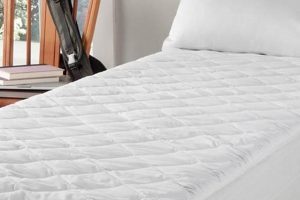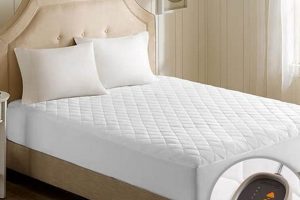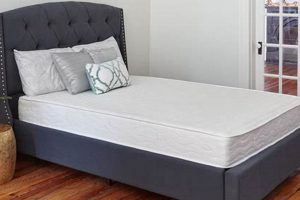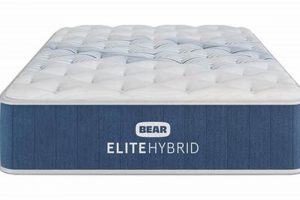A mattress exceeding standard king dimensions, generally offering additional length, provides increased sleeping space. This extended surface area caters to individuals of taller stature, ensuring adequate support from head to toe. This larger bedding option represents a specific need within the sleep solutions market.
The advantage of selecting a more expansive sleep surface lies primarily in enhanced comfort and improved sleep quality for taller individuals. Historically, standard mattress sizes often proved inadequate, leading to discomfort and disrupted rest. The introduction of extended length mattresses addresses this issue, contributing to better spinal alignment and reduced pressure points. Such accommodations can significantly impact overall well-being and daytime functionality.
Consequently, an informed purchase decision necessitates careful consideration of individual needs, bedroom dimensions, and mattress construction. The following sections will delve into specific factors influencing the selection process, including materials, support systems, and cost considerations. Understanding these elements is crucial to optimizing the sleep experience and maximizing the long-term investment.
King XL Mattress
The following guidelines provide essential information for selecting and maintaining a king XL mattress, ensuring longevity and optimal sleep quality.
Tip 1: Measure the Available Space: Before purchasing, accurately measure the bedroom to ensure sufficient space for the oversized dimensions. Account for movement around the bed and avoid overcrowding the room.
Tip 2: Consider Sleeping Habits: Assess individual sleeping positions and preferences. A side sleeper may benefit from a softer mattress, while a back or stomach sleeper may require firmer support to maintain spinal alignment.
Tip 3: Evaluate Mattress Materials: Explore various material options, including memory foam, latex, and innerspring. Each offers unique characteristics regarding support, temperature regulation, and durability. Consider certifications like CertiPUR-US to ensure low VOC emissions.
Tip 4: Investigate Support Systems: Examine the mattress’s support system, such as coil count or foam density. A robust support system contributes to long-term stability and prevents sagging.
Tip 5: Utilize a Mattress Protector: Employ a waterproof and breathable mattress protector to guard against spills, stains, and allergens. This extends the lifespan of the mattress and maintains a hygienic sleep environment.
Tip 6: Rotate the Mattress Regularly: Rotate the mattress every three to six months to promote even wear and prevent indentations. Some mattresses may also benefit from flipping, depending on the construction.
Tip 7: Maintain Proper Bed Frame Support: Ensure the bed frame provides adequate support for the mattress. A weak or unsuitable frame can compromise mattress integrity and void warranties.
Adhering to these guidelines will aid in selecting the appropriate king XL mattress and preserving its condition for years to come. Prioritizing these considerations translates to enhanced sleep quality and long-term satisfaction.
Moving forward, the article will address common concerns associated with king XL mattresses, providing solutions for optimal comfort and performance.
1. Extended Length (84 Inches)
The “Extended Length (84 Inches)” designation is a defining characteristic differentiating a king XL mattress from its standard counterpart. This dimensional specification addresses a particular need within the sleep solutions market, influencing comfort, support, and overall suitability.
- Accommodation of Taller Individuals
The primary function of the extended length is to accommodate individuals exceeding the average height. Standard mattress lengths often result in discomfort and inadequate support for taller sleepers, leading to disrupted sleep cycles and potential physical strain. The additional length ensures the entire body rests comfortably within the confines of the mattress surface, promoting proper spinal alignment.
- Improved Sleep Quality and Posture
Adequate support from head to toe contributes directly to improved sleep quality. When limbs are not forced to hang off the mattress edge, circulation improves, and pressure points are minimized. This optimized sleeping posture can alleviate back pain, reduce restlessness, and facilitate a more restorative sleep experience.
- Implications for Bed Frame Selection
The specific dimensions of the 84-inch length necessitate a compatible bed frame. Standard king frames are not designed to accommodate this extended size, requiring a specialized frame or modification to existing structures. Failure to provide adequate support can compromise the mattress’s structural integrity and void manufacturer warranties.
- Availability of Bedding Accessories
Finding appropriate bedding accessories, such as fitted sheets and mattress protectors, can present a challenge due to the non-standard dimensions. While availability has increased in recent years, consumers may need to seek out specialized retailers or opt for custom-made solutions to ensure a proper fit and prevent slippage.
In summary, the “Extended Length (84 Inches)” feature is a crucial aspect of the king XL mattress, directly impacting the comfort and suitability for taller individuals. Its presence influences not only sleep quality but also bed frame selection and the availability of compatible bedding accessories. These factors must be carefully considered to maximize the benefits of this specialized sleep surface.
2. Enhanced Spinal Alignment
Enhanced spinal alignment, a crucial ergonomic factor, is directly influenced by mattress selection, particularly in the context of a king XL mattress. The extended length of the mattress is primarily intended to accommodate taller individuals, thus preventing the common issue of limbs dangling off the edge. This accommodation becomes the foundational element for achieving improved spinal positioning during sleep. When the body is fully supported, the spinal column maintains a more natural curvature, reducing stress on the vertebrae and surrounding muscles. The consequence of proper support is diminished back pain and a decrease in the likelihood of developing chronic musculoskeletal issues. The absence of adequate mattress length, conversely, forces the sleeper to contort their body, leading to misalignment and potential discomfort. For example, an individual of six feet four inches sleeping on a standard king mattress may find themselves subconsciously adjusting their position to fit within the available space, ultimately compromising spinal health.
Further contributing to enhanced spinal alignment is the mattress’s firmness and construction materials. A king XL mattress offering targeted support through zoned coil systems or varying foam densities can provide specific relief to pressure points along the spine. The selection of appropriate materials ensures that the mattress contours to the body’s natural curves, promoting even weight distribution. Consider, for instance, a latex hybrid king XL mattress designed with a firmer core for lumbar support and a softer surface for shoulder and hip cushioning. This combination optimizes spinal alignment by maintaining proper posture throughout the night. The practical significance of this feature is evident in clinical observations indicating reduced instances of sleep-related back pain among individuals using mattresses specifically designed to promote spinal health.
In conclusion, the connection between enhanced spinal alignment and a king XL mattress hinges on the mattress’s ability to adequately support the entire body, especially for taller individuals. The extended length, coupled with appropriate firmness and material construction, contributes significantly to maintaining proper spinal curvature during sleep. While achieving optimal spinal alignment requires a multifaceted approach, including proper sleep posture and ergonomic pillows, the king XL mattress serves as a foundational element for promoting a healthier sleep experience and mitigating the risk of musculoskeletal discomfort. The challenge lies in identifying the specific mattress characteristics that best suit individual needs and preferences, necessitating careful consideration of body type, sleeping habits, and underlying health conditions.
3. Material Density Variations
Material density variations within a king XL mattress significantly influence support, comfort, and durability. The strategic manipulation of material densities allows manufacturers to target specific areas of the body and address varying support needs across the extended surface area. Understanding these variations is crucial for selecting a mattress optimized for individual requirements and long-term performance.
- Core Support and Edge Reinforcement
Higher density materials are often utilized in the core of the mattress and along the edges to provide robust support and prevent sagging. The core density directly impacts the overall firmness and the mattress’s ability to maintain its shape over time. Reinforced edges, employing higher density foam or innerspring coils, minimize edge compression and maximize usable sleeping surface, particularly relevant given the dimensions of a king XL mattress. An example is a high-density polyurethane foam core surrounded by firmer edge support, providing consistent support from edge to edge.
- Zoned Comfort Layers
Varying densities within the comfort layers allow for targeted pressure relief in specific zones, such as the shoulders and hips. Softer, lower-density materials are often used in these areas to contour to the body and alleviate pressure points, while firmer, higher-density materials support the lumbar region and prevent excessive sinking. This zoning ensures proper spinal alignment and minimizes discomfort, particularly important for side sleepers. A mattress with a lower-density memory foam layer in the shoulder region coupled with a higher-density foam in the lumbar area exemplifies this approach.
- Impact on Temperature Regulation
Material density influences airflow and heat retention within the mattress. Higher density materials tend to restrict airflow and retain heat, while lower density materials promote breathability and ventilation. The selection of materials with appropriate densities is critical for maintaining a comfortable sleep temperature, especially for individuals who tend to sleep hot. Open-cell foam with lower density facilitates air circulation compared to a closed-cell, high-density foam which traps heat.
- Durability and Longevity Implications
The density of materials directly correlates with the mattress’s durability and longevity. Higher density materials generally exhibit greater resistance to compression and degradation, resulting in a longer lifespan. However, the appropriate density must be balanced with comfort and support considerations. A very high-density foam may be exceptionally durable but could also feel uncomfortably firm. Selecting a mattress with a combination of appropriate densities, designed for both support and durability, ensures a long-term investment. Lower density materials can degrade more rapidly over time.
In summary, material density variations within a king XL mattress are essential for optimizing support, comfort, temperature regulation, and durability. These variations allow manufacturers to fine-tune the sleeping experience and cater to individual needs. The careful consideration of material densities ensures the selection of a mattress that promotes restful sleep and provides long-term satisfaction.
4. Increased Weight Capacity
The inherent size of a king XL mattress directly correlates with an increased weight capacity requirement. This stems from the greater surface area designed to accommodate multiple sleepers or individuals requiring ample space. Consequently, the internal support structure must be engineered to withstand a significantly higher static and dynamic load compared to smaller mattresses. Failure to adequately address weight capacity can result in premature sagging, compromised support, and a diminished lifespan for the product. For instance, a standard king-size mattress may be rated for 500 pounds, while a king XL intended for the same demographic often necessitates a capacity of 600 pounds or higher, reflecting the anticipated increase in distributed weight. The practical significance lies in ensuring long-term durability and preventing warranty voids due to exceeding the mattress’s design limitations. This is particularly relevant in households with multiple occupants or individuals with higher body mass indexes.
The increased weight capacity consideration extends beyond simply accommodating the combined weight of sleepers. It also encompasses the dynamic forces exerted during movement throughout the night. Tossing and turning, getting in and out of bed, and other sleep-related activities generate significant stress on the mattress structure. Therefore, the internal components, such as coil systems, foam densities, and reinforcement materials, must be selected and configured to withstand these dynamic loads without compromising structural integrity. Consider the difference between a low-density foam mattress, which may compress and deform under sustained pressure, and a hybrid mattress featuring high-density foam layers and individually wrapped coils, designed to distribute weight evenly and minimize localized stress. The latter offers superior long-term support and resistance to sagging, contributing to a more consistent and comfortable sleep experience.
In summary, increased weight capacity is an indispensable component of king XL mattresses, directly influencing their durability, support, and overall performance. The larger surface area necessitates a robust internal structure capable of withstanding higher static and dynamic loads. A proper understanding of weight capacity requirements is crucial for selecting a mattress that provides adequate support, prevents premature degradation, and ensures long-term satisfaction. Ignoring this factor can lead to discomfort, compromised sleep quality, and a significantly reduced product lifespan, ultimately negating the benefits of the extended size and potentially incurring additional replacement costs.
5. Specialized Bedding Options
The unique dimensions of a king XL mattress directly necessitate the availability of specialized bedding options. Standard king-size sheets, mattress protectors, and bed frames are inadequate for accommodating the additional length. This dimensional discrepancy results in ill-fitting linens, potentially leading to discomfort and premature wear and tear of both the bedding and the mattress itself. The specialized bedding market, therefore, emerges as a direct consequence of the increasing demand for extended-length mattresses. For example, a standard king-size fitted sheet will typically not adequately cover the corners of a king XL mattress, resulting in slippage and a compromised sleep surface. The availability of properly sized sheets, on the other hand, ensures a secure fit, preventing bunching and maintaining a smooth and comfortable sleeping area.
The importance of specialized bedding extends beyond mere aesthetic considerations. Fitted sheets designed for a king XL mattress provide enhanced protection against spills and stains, safeguarding the investment in the mattress. Similarly, mattress protectors specifically manufactured for these dimensions offer superior defense against allergens and dust mites, contributing to a healthier sleep environment. Bed frames engineered to support the extended length provide crucial structural integrity, preventing sagging and ensuring even weight distribution across the mattress surface. Instances of using a standard king-size bed frame with a king XL mattress often result in insufficient support at the foot of the bed, leading to premature wear and a potential reduction in the mattress’s lifespan. The practical application of specialized bedding, therefore, directly translates to improved comfort, enhanced protection, and increased longevity of the sleep system.
In summary, the availability and utilization of specialized bedding options are integral to maximizing the benefits of a king XL mattress. The dimensional uniqueness mandates the use of custom-fitted sheets, mattress protectors, and structurally appropriate bed frames. While the initial investment in specialized bedding may be higher than that of standard sizes, the long-term advantages in terms of comfort, protection, and mattress longevity justify the expenditure. The ongoing challenge lies in ensuring wider availability and affordability of these specialized options, particularly for consumers seeking to optimize their sleep experience with extended-length mattresses.
Frequently Asked Questions
The following questions address common inquiries and misconceptions surrounding the selection, use, and maintenance of a king XL mattress.
Question 1: What distinguishes a king XL mattress from a standard king mattress?
A king XL mattress measures 80 inches in width and 84 inches in length, offering an additional four inches in length compared to a standard king mattress, which is 80 inches wide and 80 inches long. This extended length primarily accommodates taller individuals, providing more legroom and preventing discomfort caused by feet hanging off the edge.
Question 2: Is a specialized bed frame required for a king XL mattress?
Yes, a specialized bed frame designed to accommodate the 84-inch length is recommended. A standard king-size bed frame may not provide adequate support, potentially leading to sagging and premature wear of the mattress. Utilizing a frame specifically designed for a king XL mattress ensures proper support and weight distribution.
Question 3: Are king XL mattresses universally compatible with adjustable bed bases?
Compatibility with adjustable bed bases varies. It is imperative to verify the adjustable bed base’s specifications to ensure it supports the dimensions and weight of a king XL mattress. Some adjustable bases are designed to accommodate the extended length, while others are not. Consult the manufacturer’s guidelines for compatibility information.
Question 4: What is the typical weight capacity of a king XL mattress?
Weight capacity varies depending on the mattress construction and materials. However, king XL mattresses generally possess a higher weight capacity than standard king mattresses due to their larger surface area. Refer to the manufacturer’s specifications for the specific weight capacity rating of the mattress.
Question 5: Does the increased size of a king XL mattress impact its suitability for smaller bedrooms?
The dimensions of a king XL mattress should be carefully considered in relation to the available bedroom space. Its larger size may make it unsuitable for smaller rooms, potentially restricting movement and creating a sense of overcrowding. Accurate measurements of the room are crucial before purchasing a king XL mattress.
Question 6: Are specialized cleaning and maintenance procedures necessary for a king XL mattress?
Standard mattress cleaning and maintenance procedures generally apply to king XL mattresses. Regular vacuuming, the use of a mattress protector, and periodic rotation are recommended to maintain hygiene and prolong the mattress’s lifespan. Refer to the manufacturer’s instructions for specific cleaning recommendations.
These FAQs provide essential information for making informed decisions regarding king XL mattresses. Thorough research and careful consideration of individual needs are paramount for optimal sleep quality.
The subsequent section will address advanced topics related to king XL mattresses, including material composition and construction techniques.
King XL Mattress
This exploration has detailed the defining characteristics of the king XL mattress, emphasizing its extended length and the subsequent implications for support, weight capacity, and bedding requirements. The analysis underscored the necessity for specialized bed frames and linens to maximize comfort and longevity. Understanding material density variations and the resulting impact on spinal alignment remains crucial for informed consumer decisions.
As the market evolves, further innovation in material science and construction techniques will likely yield improved designs optimized for both comfort and durability. Continued research into the ergonomic benefits and long-term health impacts of extended-length mattresses is warranted. The ultimate selection of a king XL mattress necessitates a meticulous assessment of individual needs and available resources to ensure a sound investment in sleep quality and overall well-being.







